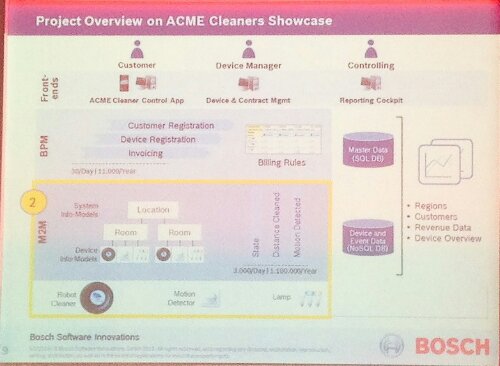I’m at Bosch Software Innovations (Bosch SI) first ConnectedWorld conference on a bit of a whim: their analyst relations included me on the standard mailer, and I responded that I could attend if they covered my travel expenses. They agreed, and here I am in Berlin — consider that also my disclaimer that Bosch has paid for my travel expenses but not for my time, so anything that I blog here is my own opinion.
The conference opened with a keynote from Dr. Rainer Kallenbach, CEO of Bosch SI. Bosch SI is the software division of Bosch that includes their internet of things (IoT) initiatives, and there’s a lot of IoT on the menu at the keynote as well as the sessions to follow. I’m a big proponent of smart devices of all sorts: beyond my smartphone, we’re playing around at home with a smart electrical switch (I confess, it currently controls the light over the cat’s daytime napping spot, but we’re considering other uses) and a smart smoke/CO alarm; I frequently use car-sharing services that have sufficient in-car connectivity to consider them as smart devices, since they track location, rental status and fuel levels. Kallenbach discussed many other home applications, including smart medication trackers to tell if someone has taken their meds and provide a reminder otherwise, smart vehicles, running shoes that monitor your runs, home security systems and more; plus smart city initiatives to improve traffic, energy, and quality of life. There are also a host of industrial and enterprise applications, such as smart machinery that sends messages to maintenance when it requires service, and smart fleet vehicles that optimize delivery routes.
Bosch SI is a fairly young division of Bosch, and created through the acquisition of a few technology players for BPM and BRM, such as the inubit acquisition just over a year ago and Visual Rules in 2008, and the development of M2M (machine-to-machine) and other related products. Questions for Kallenbach included security of internet-connected devices: there have been a few stories recently about the poor security in home-based connected devices (including in a report, however apocryphal, about a refrigerator sending spam email); the answer was pretty high level but this is obviously an area that will require close scrutiny as more devices become connected.
The second keynote was from Elmer Frickenstein, head of development of electronics at BMW, discussing IoT in the automotive industry. He started by discussing the general trend of IoT, which is to connect everything, and how Google’s recent acquisition of Nest indicates their plans to incorporate smart devices in ways that we probably can’t yet imagine. The data volume projections behind the explosion in IoT over the next five years are shockingly large, with the need for related infrastructure such as additional satellites to transmit the data. His main focus, however, was on BMW’s ConnectedDrive as the natural progression from early functionality such as in-car emergency call systems, to full communications and control systems in a vehicle. One key point is that the new BMWs now have their own SIM card to connect to the internet, hence their own IP address, providing a transport structure for them to connect for remote monitoring, but also to provide functionality such as mobile wifi hotspots for vehicle occupants. This also means that updates can be pushed to the vehicle directly, and there is an application marketplace for apps for your car: that is, the app runs on your car directly, not on your smartphone connected to your car. Think about apps that find and book parking spots for rent, or enable car-sharing, plus navigation systems with real-time traffic and weather monitoring. In the future, fully automated driving so that your car can drop you off at a meeting, then park itself? Since these apps are so closely connected with the car’s operation, the app marketplace is completely controlled and populated by BMW.
There’s a double-edged sword in all of this in-car technology: it can provide a much better driving experience as well as remote maintenance-related monitoring, but adds complexity and potential for complex system failures and security breaches. In fact, Frickenstein stated that BMW considers the data that they collect from vehicles belongs to BMW — presumably to use for vehicle health monitoring — and they consider that they have the right to sell that data to third parties. That’s going to be an extremely controversial point moving forward, especially in other countries; it’s only a short distance down that slippery slope for BMW to allow law enforcement agencies to remotely control your car, and not obvious that you have a way to opt out of this. As much as your insurance company and local police (not to mention the NSA) will love this sort of direct access to your every movement, I can imagine that a lot of people will be reluctant to risk exposing that much information and control of their vehicle to outside parties. I don’t own a car so don’t have to make that decision, but you can be sure that I will have fun with one of these new BMWs and their apps if I have the chance to drive one on loan.

